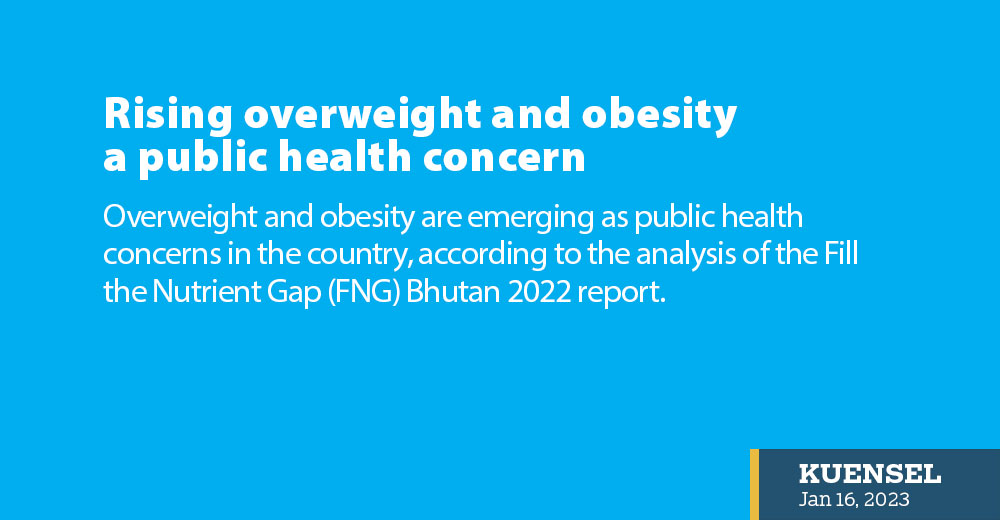Lhakpa Quendren
Overweight and obesity are emerging as public health concerns in the country, according to the analysis of the Fill the Nutrient Gap (FNG) Bhutan 2022 report.
Being overweight and obese, which significantly increases the risk of many non-communicable diseases (NCD), has been associated with cardiovascular diseases (mainly heart disease and stroke), musculoskeletal disorders, and some cancers, among others.
The Bhutan STEPS survey 2019 showed an increasing trend of rise in overweight from 26.7 percent in 2014 to 33.5 percent in 2019 and obesity from 6.2 percent to 11.4 percent.
The younger age between 15 to 24 years had the highest prevalence of underweight and lowest prevalence of overweight and obesity while it was the opposite for those in the age group of 40 to 54 years.
The report showed that women in urban areas have a significantly higher prevalence of overweight and obesity compared to their counterparts. And the eastern region has the highest prevalence of overweight and obesity.
The National Nutrition Survey 2015 showed that the prevalence of overweight children under five years of age is 3.9 percent.
According to the 2018 Global Nutrition Report, Bhutan has shown limited progress toward achieving the diet-related NCD targets.
“The country has shown no progress towards achieving the target on obesity.”
The report showed that Bhutan’s obesity prevalence is equal to the regional average of 10.3 percent for women but is lower than the regional average of 7.5 percent for men.
Interventions
Given the prevalence of increasing overweight and obesity with increasing household wealth, the health ministry has developed a multi-sectoral action plan on NCDs and the promotion of a healthy food environment.
A nutritionist with the health ministry’s public health department, Hari Prasad Pokhrel, said that the action plan will bring together the relevant stakeholders and the development partners to address the NCDs including overweight and obesity.
“We are talking about the reduction of salt and fat, taxing unhealthy foods or making them unavailable for the population,” he said. “We are trying to make space for physical activity available.”
He said that the health ministry is also working with the agriculture ministry to improve the overall food system in the country. “Healthy foods will be made available to the general population and screening programmes will be made more reachable.”
“We also started creating advocacy to the local leaders through which the information will be disseminated to the grassroots while health felicities in the community will continue to do so,” said Hari Prasad Pokhrel.
The interventions include children’s growth monitoring and promotion programs through health facilities, infant and young child feeding counselling, school health programme, and community advocacy and awareness programs, among others.
The health ministry will also conduct a national health survey in the second quarter of this year to capture the updated and the latest data for planning and programming.
Hari Prasad Pokhrel said that increasing overweight and obesity was also a growing concern for the ministry because of the sedentary lifestyle and changing food consumption patterns.
“As the population moves to overweight and obesity, this will lead to NCDs and its associated complications,” he said. “There is a lack of time and space for physical activity.”
Overweight and obesity are increasing in almost every country and are a real concern in many low and middle-income countries. It is the fifth leading risk for global deaths and it leads to the death of at least 2.8 million adults each year.


